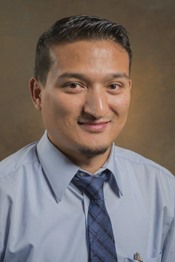Program Information
Improving Prescription Dose Accuracy in Total Body Irradiation Using Treatment Planning System for 15 MV Beam
S Prajapati1*, D Lewis2 , S Tung1 , R Tailor1 , P Chi1 , (1) MD Anderson Cancer Center, Houston, TX, (2) Texas Oncology, PA, Fort Worth, TX
Presentations
SU-I-GPD-T-502 (Sunday, July 30, 2017) 3:00 PM - 6:00 PM Room: Exhibit Hall
Purpose: The purpose of this study was to compare the accuracy of our current clinical practice for total body irradiation (TBI) prescription using a tissue-maximum ratio (TMR)-based lookup table (LUT) to the dose calculated using a treatment planning system (TPS) and apply correction factors when necessary.
Methods: We commissioned a 15MV TBI AP/PA technique at extended SAD (400cm) at our institution. Traditionally, a TMR-based LUT is used for prescribing to umbilicus midline using the measured patient thickness at umbilicus level. We first validated the 15MV model (commissioned for standard SAD=100cm) for TBI dose calculation in Pinnacle™ TPS using TLD measurements in an anthropomorphic phantom. Next, the MUs required to deliver 300cGy were compared between a TMR-based LUT and Pinnacle™ calculation for wide ranges of patient thicknesses including pediatric cases (separation: 10cm to 47cm). The comparison datasets included 15 adult patients with TBI simulation CT scans and two rectangular water phantoms (separation: 10cm and 20cm) to simulate pediatric cases. TBI treatment plans were generated for each scan positions using both AP-PA beams using heterogeneous dose calculation in Pinnacle™ TPS.
Results: Calculated dose from Pinnacle™ TPS for the 15MV TBI beam at prescription umbilicus midline agreed within 1% with TLD measurements. The TMR-based LUT overestimated dose linearly between 1% and 10% compared to Pinnacle™ TPS from 10cm to 47cm separation. MU disagreement was higher for patients with larger separations. A linear correction factor as a function of body separation on the TMR-based LUT can be applied to improve the accuracy of the TBI prescription for patients with different sizes.
Conclusion: We developed a correction table as a function of body separation to apply on the TMR-based TBI LUT. Since most of our TBI patients do not currently go to CT simulation, this method can improve the accuracy of the TMR-based 1D LUT.
Contact Email:
